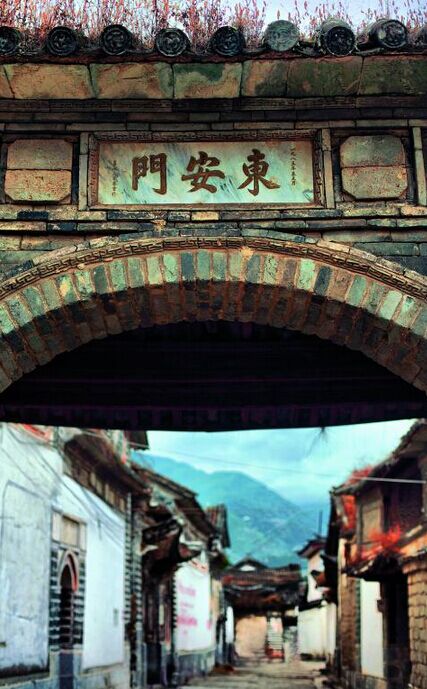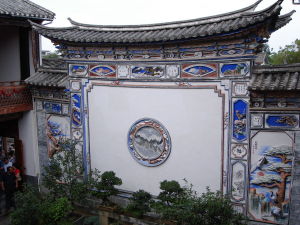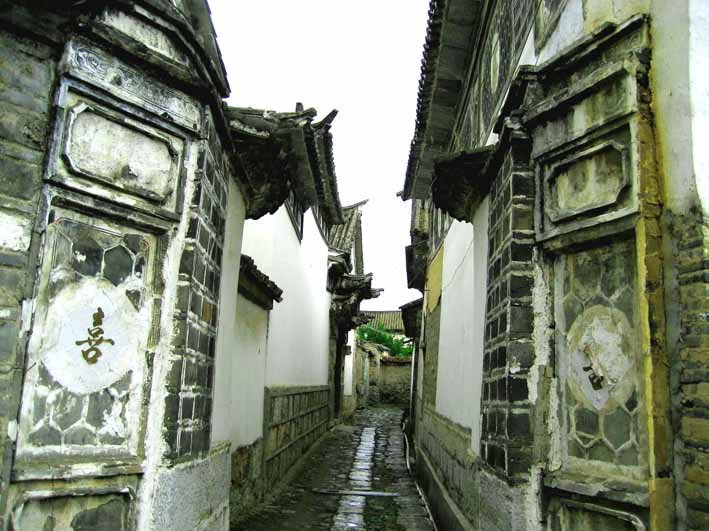Ancient Culture of Xizhou Old Town in Dali
A Glimpse of Cambridge of the Orient
In his book Notes of Trips in Yunnan (written in 1941), the famous Chinese writer Lao She (1899–1966) called Xizhou the “Cambridge of the Orient.” How did Xizhou earn this title? Let’s visit this little ancient town and get a glimpse of its stunning beauty.
Journeying north along the Dali–Lijiang Highway, the Cangshan Mountains filled the view on the west side of the road, while the east side was the mirror-like Erhai Lake. Between the green and blue tableau was a wisp of pure white: my first glimpse of Xizhou.
 Xizhou has no city walls but it has gates. Entering through the west gate, one sees the structure of the Zhengyi Gate (the Gate of Righteousness), which is constructed in a pavilion style. Facing east from Zhengyi Gate, one sees a road which stretches onwards as far as the eye can see. Both sides are uniformly lined by more than a dozen white-walled courtyard homes with jet-black roofs, all facing east, as though the structures were constructed according to one master plan. Traditional logic holds that, having experienced centuries of wind and rain, the white walls should long ago have become mottled; yet, the walls here shine like new because any time the building facades are damaged, the owners quickly come to make repairs and the walls are frequently white-washed. Is this, then, what Lao She saw when he first set foot here, so long ago?
Xizhou has no city walls but it has gates. Entering through the west gate, one sees the structure of the Zhengyi Gate (the Gate of Righteousness), which is constructed in a pavilion style. Facing east from Zhengyi Gate, one sees a road which stretches onwards as far as the eye can see. Both sides are uniformly lined by more than a dozen white-walled courtyard homes with jet-black roofs, all facing east, as though the structures were constructed according to one master plan. Traditional logic holds that, having experienced centuries of wind and rain, the white walls should long ago have become mottled; yet, the walls here shine like new because any time the building facades are damaged, the owners quickly come to make repairs and the walls are frequently white-washed. Is this, then, what Lao She saw when he first set foot here, so long ago?
Time here seems fixed, unchanging. The residences lining the street are both ornate and orderly: all arranged in either the “three buildings, one screen wall” or “four houses, five patios” style. The so-called “three houses, one screen wall” is, obviously, comprised of three houses and one screen wall. The screen wall is a wall erected within the main gate of the complex for privacy. The screen is white and is also a unique architectural feature influenced by China’s fengshui theory. It surrounds the courtyard and also acts as the courtyard wall. The screen is inscribed with writing. The“four houses, five patios”consists of central courtyards and four patios, each similar to the Chinese character jing (井, which literally means a well water is drawn from), with the intersection of each patio forming a larger courtyard, creating four small patios and one central courtyard, for a total of five.
At the eastern end of Xizhou’s Shishang Street, there is a public square surrounded by shops, which is home to a large concentration on traders and merchants. In today’s era of tourism, such merchants are a common site, yet the town is home to a surprising number of old shops and one can readily see that the area has long been home to a developed commercial culture.


With its luxurious yet delicate architecture, bustling streets and warm inhabitants, it is no wonder that Lao She was moved to call this orderly little town the Cambridge of the Orient.

 7 Days GolfingTour
7 Days GolfingTour
 8 Days Group Tour
8 Days Group Tour
 8 Days Yunnan Tour
8 Days Yunnan Tour
 7 Days Shangri La Hiking
7 Days Shangri La Hiking
 11 Days Yunnan Tour
11 Days Yunnan Tour
 6 Days Yuanyang Terraces
6 Days Yuanyang Terraces
 11 Days Yunnan Tour
11 Days Yunnan Tour
 8 Days South Yunnan
8 Days South Yunnan
 7 Days Tea Tour
7 Days Tea Tour
 8 Days Muslim Tour
8 Days Muslim Tour
 12 Days Self-Driving
12 Days Self-Driving
 4 Days Haba Climbing
4 Days Haba Climbing
 Tiger Leaping Gorge
Tiger Leaping Gorge
 Stone Forest
Stone Forest
 Yunnan-Tibet
Yunnan-Tibet
 Hani Rice Terraces
Hani Rice Terraces
 Kunming
Kunming
 Lijiang
Lijiang
 Shangri-la
Shangri-la
 Dali
Dali
 XishuangBanna
XishuangBanna
 Honghe
Honghe
 Kunming
Kunming
 Lijiang
Lijiang
 Shangri-la
Shangri-la
 Yuanyang Rice Terraces
Yuanyang Rice Terraces
 Nujiang
Nujiang
 XishuangBanna
XishuangBanna
 Spring City Golf
Spring City Golf
 Snow Mountain Golf
Snow Mountain Golf
 Stone Mountain Golf
Stone Mountain Golf











